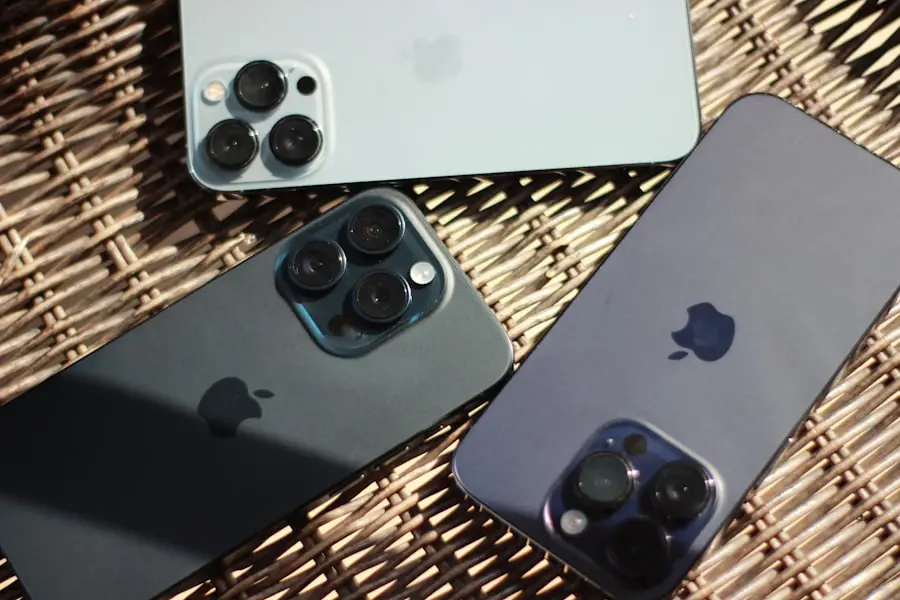The iPhone 11 Pro, launched in September 2019, marked a significant milestone in Apple’s smartphone lineup, particularly in terms of camera technology. With its sleek design and powerful performance, the device quickly garnered attention from both consumers and critics alike. Apple positioned the iPhone 11 Pro as a premium offering, emphasizing its capabilities in photography and videography, which have become increasingly important to users in the age of social media and content creation.
The introduction of this model not only showcased Apple’s commitment to innovation but also set a new standard for what users could expect from a smartphone camera. At the heart of the iPhone 11 Pro’s appeal is its advanced camera system, which was a focal point of Apple’s marketing strategy. The device was equipped with a triple-camera setup that allowed users to capture stunning images and videos in a variety of conditions.
This evolution in camera technology was not merely an incremental upgrade; it represented a paradigm shift in how smartphones could be used for photography. With features designed to enhance user experience and creativity, the iPhone 11 Pro aimed to empower both amateur photographers and seasoned professionals alike.
Key Takeaways
- The iPhone 11 Pro introduces a triple camera system, enhanced video capabilities, and improved low-light performance, making it a game-changer in smartphone photography.
- The evolution of iPhone cameras has seen a significant improvement in image quality, from the first iPhone to the latest iPhone 11 Pro.
- The triple camera system on the iPhone 11 Pro includes ultra-wide, wide, and telephoto lenses, allowing users to capture a wider range of perspectives and details.
- The introduction of Night Mode and improved low-light performance on the iPhone 11 Pro enables users to capture stunning photos in low-light conditions.
- Enhanced video capabilities, computational photography, and Smart HDR further solidify the iPhone 11 Pro as a powerhouse in smartphone photography, setting the stage for the future of smartphone photography.
The Evolution of iPhone Cameras
The journey of iPhone cameras began with the original iPhone, which featured a modest 2-megapixel camera that was primarily designed for casual snapshots. Over the years, Apple has consistently pushed the boundaries of mobile photography, introducing new technologies and features with each iteration. The introduction of the iPhone 4 in 2010 marked a significant leap forward with its 5-megapixel camera and the addition of features like LED flash and HD video recording.
This evolution continued with subsequent models, each bringing enhancements that catered to the growing demand for high-quality mobile photography. By the time the iPhone 7 was released, Apple had already integrated optical image stabilization and improved low-light performance, setting the stage for even more advanced capabilities. The iPhone X introduced Portrait Mode, allowing users to create images with a shallow depth of field, mimicking the effects typically achieved with professional cameras.
Each new model built upon the last, incorporating advancements in sensor technology, image processing, and software algorithms. The iPhone 11 Pro represented the culmination of this evolution, combining hardware and software innovations to deliver an unparalleled photography experience.
The Triple Camera System

One of the most notable features of the iPhone 11 Pro is its triple-camera system, which consists of an ultra-wide lens, a wide lens, and a telephoto lens. This configuration allows users to capture a broader range of perspectives and compositions than ever before. The ultra-wide lens, with a 120-degree field of view, enables users to fit more into their frame, making it ideal for landscape photography or capturing large groups of people.
The wide lens serves as the primary camera for most shooting scenarios, delivering exceptional image quality and detail. The telephoto lens adds another layer of versatility, allowing users to zoom in on subjects without sacrificing image quality. This lens is particularly useful for portrait photography, where it can create flattering images with a natural bokeh effect.
The seamless integration of these three lenses allows for smooth transitions between different focal lengths, providing users with creative freedom to experiment with their shots. This innovative approach to camera design not only enhances the photographic capabilities of the device but also reflects Apple’s understanding of how users engage with their smartphones.
Ultra-Wide, Wide, and Telephoto Lenses
| Lens Type | Field of View | Aperture Range | Minimum Focusing Distance |
|---|---|---|---|
| Ultra-Wide | Greater than 100 degrees | f/2.8 – f/22 | Less than 0.3 meters |
| Wide | 60-100 degrees | f/2.8 – f/16 | 0.3 – 0.5 meters |
| Telephoto | Less than 30 degrees | f/2.8 – f/32 | Greater than 1 meter |
The ultra-wide lens on the iPhone 11 Pro is a game-changer for photographers looking to capture expansive scenes. With its 12-megapixel sensor and f/2.4 aperture, this lens allows for dramatic perspectives that were previously difficult to achieve with standard smartphone cameras. Whether photographing sweeping landscapes or tight indoor spaces, the ultra-wide lens opens up new creative possibilities.
Users can capture more context in their images, making it easier to tell a story through their photography. The wide lens remains the backbone of the iPhone 11 Pro’s camera system. With an f/1.8 aperture and advanced sensor technology, it excels in various lighting conditions, producing sharp images with vibrant colors and excellent dynamic range.
This lens is versatile enough for everyday photography, from casual snapshots to more deliberate compositions. Meanwhile, the telephoto lens offers a unique advantage by allowing users to zoom in on distant subjects without losing detail. With an f/2.0 aperture, it performs admirably in low-light situations while providing that coveted portrait effect that blurs backgrounds beautifully.
Night Mode and Improved Low-Light Performance
One of the standout features introduced with the iPhone 11 Pro is Night Mode, which revolutionizes low-light photography on smartphones. This feature automatically activates when the camera detects low-light conditions, allowing users to capture stunning images without resorting to flash or external lighting sources. Night Mode utilizes advanced algorithms to combine multiple exposures into a single image, resulting in bright and detailed photos even in challenging lighting situations.
The improvements in low-light performance are not limited to Night Mode alone; they extend across all three lenses of the iPhone 11 Pro’s camera system. The larger sensors and improved image processing capabilities work together to minimize noise and enhance clarity in dimly lit environments. Users can now confidently take photos at night or in poorly lit settings without worrying about grainy or washed-out results.
This capability has transformed how people approach nighttime photography, enabling them to capture moments that were once deemed impossible with a smartphone.
Enhanced Video Capabilities

In addition to its impressive still photography features, the iPhone 11 Pro also boasts enhanced video capabilities that cater to content creators and casual users alike. The device supports 4K video recording at up to 60 frames per second across all three cameras, allowing for stunningly smooth footage that captures every detail. This versatility makes it an ideal choice for filmmakers and vloggers who require high-quality video output without the need for bulky equipment.
The introduction of features like extended dynamic range further elevates the video recording experience on the iPhone 11 Pro. Users can capture scenes with high contrast—such as bright skies against dark landscapes—without losing detail in either extreme. Additionally, the ability to shoot in slow motion at 240 frames per second adds an artistic touch to videos, enabling creators to highlight specific moments with dramatic effect.
With these capabilities at their fingertips, users can produce professional-grade videos directly from their smartphones.
Computational Photography and Smart HDR
At the core of the iPhone 11 Pro’s photographic prowess lies computational photography—a term that encompasses various software-driven techniques designed to enhance image quality and creativity. One of the most significant advancements in this area is Smart HDR (High Dynamic Range), which intelligently captures multiple exposures and combines them into a single image that retains detail across highlights and shadows. This technology ensures that photos taken in challenging lighting conditions appear balanced and true-to-life.
Computational photography also extends to features like Portrait Mode and Depth Control, which allow users to manipulate background blur after taking a photo. This level of control empowers photographers to refine their images according to their artistic vision. Furthermore, Apple’s machine learning algorithms analyze scenes in real-time, optimizing settings such as exposure and color balance automatically.
This seamless integration of hardware and software not only simplifies the photography process but also elevates the overall quality of images captured on the iPhone 11 Pro.
The Future of Smartphone Photography
As we look toward the future of smartphone photography, it is clear that devices like the iPhone 11 Pro have set a high bar for innovation and performance. The combination of advanced hardware features—such as multiple lenses and improved sensors—with sophisticated software capabilities like computational photography has transformed how we think about mobile imaging. As technology continues to evolve, we can expect even more groundbreaking developments that will further enhance our ability to capture and share our experiences.
The trajectory of smartphone cameras suggests that future devices will continue to push boundaries, integrating artificial intelligence and machine learning to create even more intuitive user experiences. As consumers increasingly rely on their smartphones for professional-quality photography and videography, manufacturers will be compelled to innovate continuously. The iPhone 11 Pro serves as a testament to this ongoing evolution—a device that not only meets but exceeds user expectations in an ever-changing digital landscape.
The latest iPhone model has been making waves in the tech world with its innovative design, including a triple camera system. This feature allows users to capture stunning photos and videos with enhanced clarity and depth. For more information on the benefits of having three cameras on an iPhone, check out this article on getiphoneinfo.com.
FAQs
What iPhone model has 3 cameras?
The iPhone 11 Pro and iPhone 11 Pro Max are the models that feature 3 cameras on the back.
What are the three cameras used for on the iPhone 11 Pro?
The three cameras on the iPhone 11 Pro consist of a wide, ultra-wide, and telephoto lens, allowing for a variety of photography options including wide-angle shots, zoomed-in shots, and panoramic views.
What are the benefits of having 3 cameras on an iPhone?
Having 3 cameras on an iPhone allows for enhanced photography capabilities, including improved low-light performance, better zoom capabilities, and the ability to capture a wider field of view.
Are there any other iPhone models with 3 cameras?
As of now, the iPhone 11 Pro and iPhone 11 Pro Max are the only models with 3 cameras. Other iPhone models may have dual-camera setups, but not three.
Do all iPhone 11 models have 3 cameras?
No, only the iPhone 11 Pro and iPhone 11 Pro Max have 3 cameras. The standard iPhone 11 model has a dual-camera setup.











1 thought on “iPhone 11 Pro: The Triple Camera Revolution”